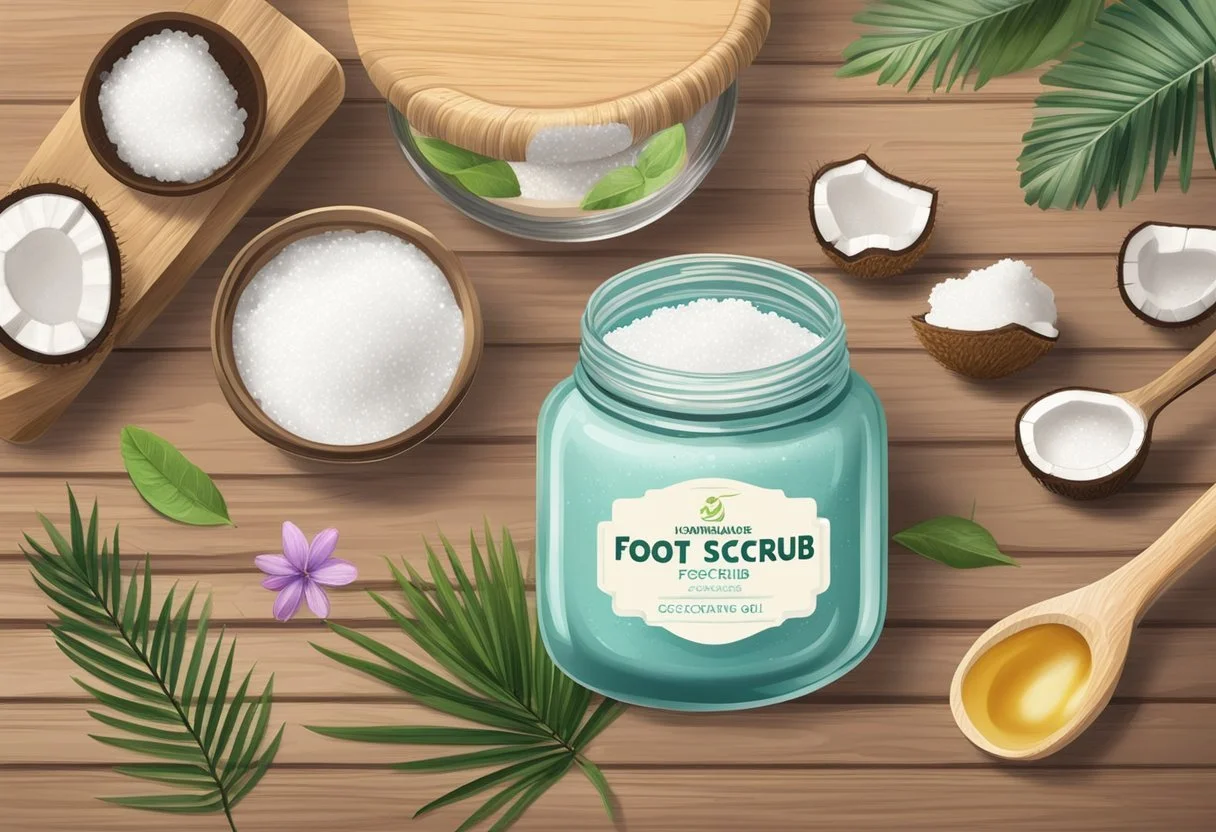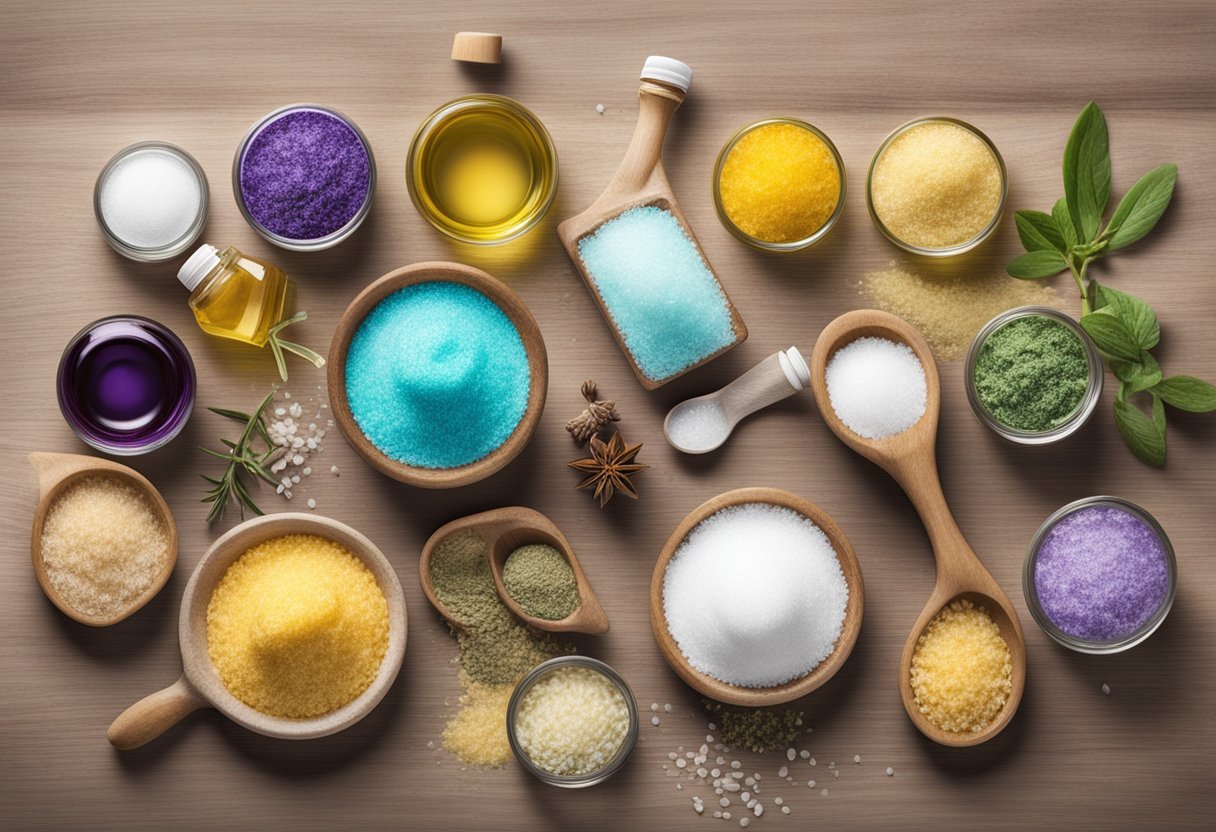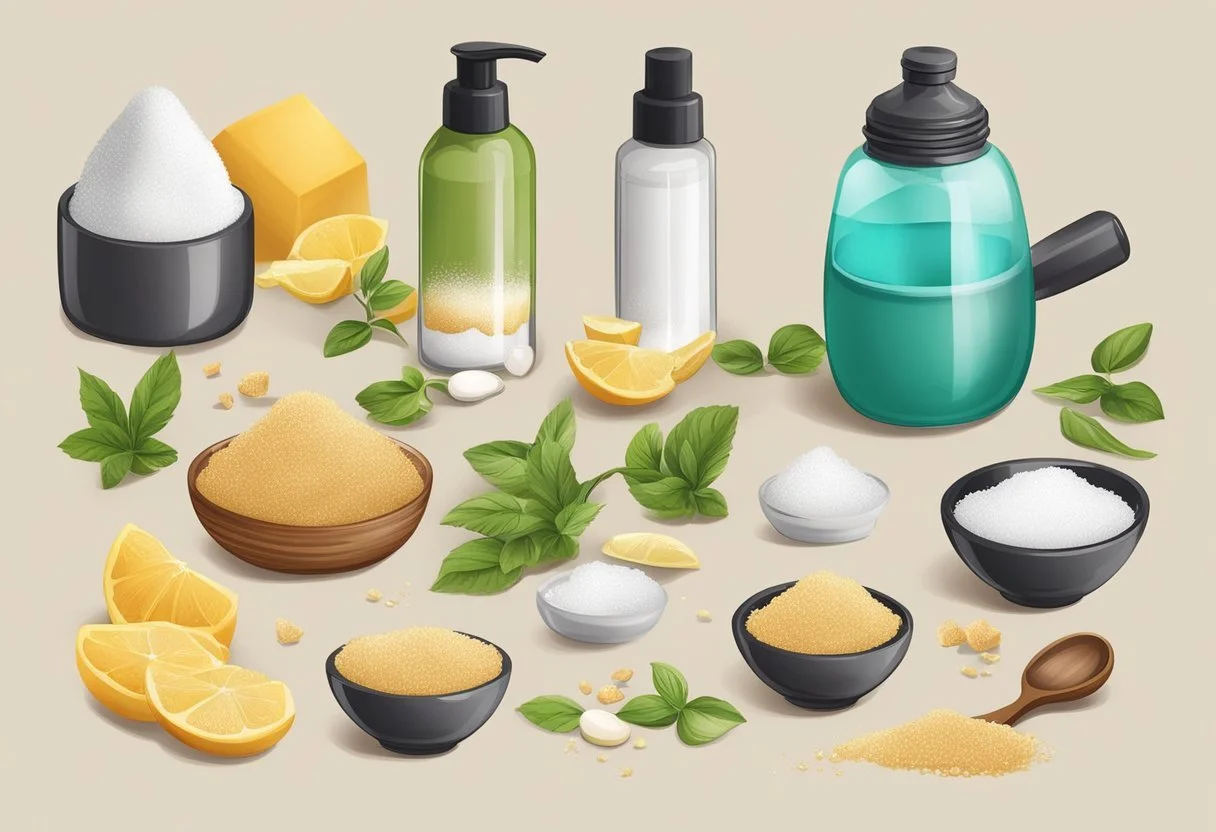Best Foot Scrub Recipes
Simple and Effective Solutions for Smooth Skin
This article is part of our series on Natural Health
Discover > Natural Health > Best Foot Scrub Recipes
Taking care of one's feet is an essential part of a healthy self-care routine. Just as the facial skin needs exfoliation, feet too can benefit from the same to get rid of dead skin cells and reveal smoother, softer skin beneath. One of the best ways to achieve this is by using foot scrubs, which not only exfoliate but also moisturize the feet.
There are plenty of foot scrub recipes that can be easily made at home using natural ingredients, many of which may already be present in one's pantry. These homemade foot scrubs typically use a combination of an exfoliating agent, such as sugar (how long does sugar last?) or salt, and a moisturizing element, like oils or butters, to offer a luxurious self-care experience without the need for expensive spa treatments.
In this article, we will be sharing some of the best foot scrub recipes that can be customized to one's individual needs or preferences. The recipes are easy to follow, require minimal preparation time, and are most importantly, effective in delivering soft, smooth, and rejuvenated feet.
The Purpose of Foot Scrubs
Foot scrubs serve as an essential component of a comprehensive skincare routine. They specifically target the feet, an area often neglected in daily care. The primary purpose of a foot scrub is to exfoliate dead skin cells, allowing for a smoother, fresher, and more revitalized appearance.
Exfoliation is the process of removing the top layer of dead skin cells, which can accumulate over time due to friction and pressure. This buildup can lead to the formation of calluses, particularly on the heels and balls of the feet. By utilizing exfoliating granules in foot scrubs, one can effectively break down and loosen these dead skin cells, revealing the healthier skin underneath.
Natural beauty enthusiasts appreciate foot scrubs for their gentle yet effective approach to exfoliation. Many homemade foot scrub recipes incorporate easily accessible ingredients, such as sugar, salt, and coffee grounds. These exfoliators provide a customizable means of addressing specific skincare concerns, while simultaneously promoting sustainable and eco-friendly practices.
In conclusion, foot scrubs are an integral part of maintaining overall skin health and well-being. By incorporating this simple and natural beauty practice into one's routine, one's feet can remain soft, smooth, and refreshed.
Essential Ingredients for Foot Scrubs
A foot scrub is a vital component of any at-home pedicure routine. There are several key ingredients that can be used in various combinations to create the ultimate foot scrub. In this section, we will explore some of the most popular and effective ingredients for foot scrubs.
Sugar and salt are two common exfoliating agents present in foot scrubs. They help to remove dead skin cells and reveal softer, smoother skin. Brown sugar, white sugar, Epsom salts (how long does epsom salt last?), and pink Himalayan salt are popular choices for a foot scrub base.
Oils play a vital role in moisturizing and nourishing the skin. Coconut oil, olive oil, jojoba oil, and sweet almond oil are widely used in foot scrubs for their moisturizing properties. These oils are easily absorbed by the skin and leave it feeling soft and smooth.
Herbs and essential oils provide fragrance and therapeutic benefits to foot scrubs. Mint, lemon, and vanilla extract can invigorate and refresh tired feet, while lavender and chamomile have soothing and calming properties. Essential oils like lemon, peppermint, and tea tree oil also boast antibacterial and antifungal properties that can support foot health.
Natural humectants such as honey and raw honey help to hydrate the skin by drawing moisture from the air and locking it into the skin. Additionally, honey possesses antimicrobial properties that can aid in preventing infections.
Oatmeal is a gentle exfoliant, perfect for sensitive skin. It offers soothing and anti-inflammatory properties, making it a suitable addition to foot scrubs, especially for those with irritated or inflamed skin.
Baking soda and vinegar are optional ingredients that can be incorporated into foot scrubs for additional benefits. Baking soda (how long does baking soda last?) can help neutralize foot odor, while apple cider vinegar can help to combat fungal infections, like athlete's foot.
Butters and moisturizers are often added to foot scrubs to provide an extra layer of hydration. Shea butter is a popular ingredient with high levels of nourishing fatty acids and vitamins. It can be combined with other ingredients to create a luxurious, moisturizing foot scrub.
With a myriad of ingredients to choose from, one can easily create a customized foot scrub to address various foot care needs. Just remember to be mindful of potential allergies or sensitivities when selecting ingredients.
Types of Foot Scrubs
Foot scrubs are essential for the health and appearance of our feet. They help to exfoliate, moisturize, and rejuvenate the skin, and there are various types of foot scrubs available. This section will discuss the different types of foot scrubs, including salt-based, sugar-based, coffee-based, and clay-based foot scrubs.
Salt Based Foot Scrubs
Salt-based foot scrubs are known for their exfoliating and detoxifying properties. One popular salt foot scrub recipe involves mixing sea salt (how long does sea salt last?) or Epsom salt with a carrier oil such as olive or coconut oil. Adding a few drops of essential oils, like lavender or peppermint, provides additional benefits and a pleasing aroma. A refreshing lemon foot scrub can be created by combining sea salt with lemon juice, making for a thorough cleanse and fresh feel.
Sugar Based Foot Scrubs
Sugar-based foot scrubs are gentler on the skin compared to salt scrubs. They effectively remove dead skin cells and can be customized with various ingredients. For a simple DIY foot scrub, mix sugar (white or brown), a carrier oil, and a few drops of essential oil. A homemade foot scrub like pineapple and yogurt foot scrub helps to hydrate and nourish the skin. To make it, combine sugar, pineapple puree, and yogurt for a soothing and fruity experience.
Coffee Based Foot Scrubs
Coffee-based foot scrubs are popular for their exfoliating properties and energizing aroma. To make a coffee scrub, simply mix coffee grounds with a carrier oil, and add a few drops of essential oils for fragrance. Coffee scrubs are a fantastic choice for those who wish to achieve smoother and more radiant skin. The caffeine in these scrubs stimulates blood flow, which can help reduce the appearance of cellulite and bring a healthy glow to the skin.
Clay Based Foot Scrubs
Clay-based foot scrubs have the unique ability to draw out impurities and toxins from the skin. A clay foot mask is perfect for individuals who are looking for a natural foot scrub that cleanses and detoxifies. To create a clay scrub, combine, and thoroughly mix bentonite or kaolin clay with a small amount of water and a few drops of essential oil. Apply the mixture to the feet and let it dry before rinsing it off. This scrub not only exfoliates but also helps improve the overall complexion and texture of the skin.
Each of these foot scrubs offers unique benefits and can cater to different preferences and skin types. Experimenting with a variety of ingredients and adjusting proportions allows for customization, ensuring optimal results for each individual's needs.
Step-by-Step DIY Foot Scrub Recipes
Creating your own foot scrub recipe at home is easy and rewarding. By mixing simple ingredients, you can create a scrub tailored to your specific needs and preferences. DIY foot scrubs can save money while allowing you to have a spa-like experience at home. Let's dive into some popular recipes.
Recipe 1: Sugar and Coconut Oil Foot Scrub
In a mixing bowl, combine 1 cup of granulated sugar and 1/2 cup of coconut oil.
Mix ingredients thoroughly using a spoon or spatula until you achieve a smooth consistency.
Optionally, add a few drops of your favorite essential oil for fragrance or additional skin benefits.
Store the scrub in a mason jar or airtight container.
This foot scrub recipe has a pleasant texture, and sugar helps gently exfoliate dead skin cells, while coconut oil moisturizes and softens the skin.
Recipe 2: Salt, Olive Oil, and Lemon Foot Scrub
Combine 1 cup of sea salt or Epsom salt with 1/2 cup of olive oil in a mixing bowl.
Mix well using a spoon or spatula.
Add the juice of half a lemon and stir until evenly mixed.
Transfer the scrub to a mason jar or airtight container.
The salt in this recipe provides a natural exfoliant, while olive oil acts as a moisturizer. Lemon juice offers a refreshing scent and has antibacterial properties.
All these recipes are easy to make, as they only require a few simple steps and tools, such as a mixing bowl, spoon, and mason jar. Regardless of the scrub you choose, always remember to gently massage the mixture onto your feet, taking care not to be too rough or vigorous to avoid irritation. Rinse the scrub thoroughly afterward to remove any trace of residue.
In summary, these foot scrub recipes are versatile, easy to make, and packed with nourishing ingredients. DIY beauty recipes allow you to customize the scrub to fit your preferences while saving money and enjoying spa-quality pampering at home.
Dealing with Specific Foot Issues
Foot Scrubs for Dry and Cracked Heels
Dry and cracked heels can be both uncomfortable and unsightly. A nourishing foot scrub can help restore moisture and remove dead skin cells. Try a mixture of 2 tablespoons of sugar, 1 tablespoon of coconut oil, and a few drops of lavender essential oil. Gently massage the mixture onto each heel for 5 minutes before rinsing with warm water. Use a pumice stone to buff away any stubborn patches of cracked skin. For added hydration, finish with a rich foot cream or apply a foot mask before bed.
Foot Scrubs for Excessive Foot Odor
Excessive foot odor is a common concern for many people. A foot scrub containing antibacterial ingredients can help reduce odor and promote a fresher feel. Prepare a scrub by combining 2 tablespoons of Epsom salt, 1 tablespoon of baking soda, and 1 tablespoon of lemon juice. Add a few drops of tea tree essential oil for its natural antifungal and antibacterial properties. Soak feet in a warm water foot soak for 10 minutes, then massage the scrub onto affected areas. Rinse with cool water and pat dry.
Foot Scrubs for Tired and Achy Feet
Tired, achy feet can benefit from a soothing foot scrub that encourages relaxation and blood flow. Combine 2 cups of coarse salt with 1 cup of olive oil, and add a few drops of peppermint essential oil. Mix in 1 tablespoon of dried rosemary (how long does dried rosemary last?) leaves for additional anti-inflammatory properties.
Gently massage the scrub onto tired and achy feet, focusing on areas of tension or pain. Rinse with warm water, and consider giving your feet a rest by elevating them. For an extra relief, follow up with a cooling foot cream or a massage using a soothing blend of essential oils.
Additional Tips for Foot Care
After using a homemade foot scrub, there are several additional steps you can take to ensure your feet feel rejuvenated and well cared for. Moisturizing and exfoliating are essential to keep your feet healthy and rejuvenated.
Firstly, exfoliation is an important step that shouldn't be overlooked. Consider using a gentle scrub, like a hand scrub, to remove dead skin cells from tired feet. Not only do hand scrubs work well on feet, but they can also be used for general skin care and body care. Exfoliating regularly helps in revealing smoother skin and prepares your feet for sandal season.
Secondly, after exfoliating, it's vital to moisturize your feet to keep them soft and smooth. Just like you would care for the rest of your body, ensure you're using a high-quality moisturizer that helps hydrate and replenish your skin. Pay special attention to dry areas, like heels, for a more enjoyable home pedicure experience.
Storing your foot scrub in an airtight container is also important. A well-sealed container will keep your scrub fresher longer, maintaining its effectiveness.
Lastly, remember to take care of your feet daily, not just during sandal season or when they feel particularly tired. Incorporate foot care into your routine by moisturizing, exfoliating, and using comforting treatments to enjoy smooth and refreshed feet year-round.
Cost and Benefits of Homemade Foot Scrubs
Homemade foot scrubs are an affordable and effective way to maintain soft and healthy feet. In comparison to store-bought products, making your foot scrub can save you money in the long run. Additionally, DIY foot scrubs allow you to customize the ingredients, tailoring them to your preferences and needs.
During winter and summer months, taking care of our feet is equally important. Cold weather often leaves our skin dry and chapped, while the summer season may result in sweaty and tired feet. Homemade foot scrubs provide an all-year-round solution to these issues.
A variety of ingredients can be utilized in homemade foot scrubs, some of which you may already have in your pantry. A simple yet effective blend of oils, such as grapeseed oil (how long does grapeseed oil last?) and avocado oil, create a nourishing base for the scrub. These oils are known for their hydrating properties, leaving your skin smooth and moisturized.
Adding essential oils, such as peppermint and lavender, not only provide a pleasant scent but also offer therapeutic benefits. Peppermint essential oil can help with cooling and refreshing tired feet, while lavender essential oil is known for its calming and soothing properties.
Lemon, milk, and coffee grounds can be incorporated into your homemade foot scrub as natural exfoliants. Lemon assists in brightening the skin, whereas milk gently exfoliates and softens without being too harsh. Coffee grounds provide a more vigorous scrubbing texture, ideal for removing dead skin cells.
It is important to remember that making a homemade foot scrub may not be appropriate for everyone. Those with sensitive skin or specific skin conditions should consult a dermatologist before trying any new skincare.
In conclusion, homemade foot scrubs offer a cost-effective and customizable solution for maintaining healthy feet throughout the year. By experimenting with different ingredients and finding the right combination, you can create a foot scrub specifically tailored for your needs.
Conclusions
Incorporating foot scrubs into one's skincare routine can provide numerous benefits, such as softer skin and improved circulation. Utilizing natural ingredients, like sugar and coffee grounds, can yield effective and affordable exfoliation.
Adding moisturizing agents, like coconut oil, almond oil, and shea butter, can help nourish and soothe the skin. Essential oils can offer additional benefits, like anti-inflammatory and anti-bacterial properties, while providing pleasant scents. A few popular essential oils to consider are peppermint, eucalyptus, and lavender.
Some recommended foot scrub recipes are:
Sugar and coconut oil scrub: Mix equal parts sugar and coconut oil; add a few drops of your preferred essential oil for fragrance.
Coffee and almond oil scrub: Combine coffee grounds with almond oil, and incorporate a few drops of essential oil for added benefits and aroma.
Sea salt and shea butter scrub: Blend sea salt with melted shea butter, and enrich the mixture with a few drops of essential oil.
In summary, customizing and experimenting with various ingredients allows for tailor-made foot scrubs that cater to individual preferences and skin types. Regular use of these scrubs can result in smoother, healthier skin. Place emphasis on quality ingredients and proper techniques for optimal outcomes.
Natural Health: From Skin Care to Greenhouses
Natural health is a holistic approach to wellness that focuses on using natural remedies and resources to support the body's natural healing processes. When it comes to skin care, body butter is a popular natural option for hydrating and moisturizing the skin. To use body butter, simply apply a small amount to the skin and massage gently until absorbed.
Herbs can also be a valuable resource for natural health, including for eye care. Herbs like chamomile, calendula, and fennel (how long does fennel last?)can be used to make an eye wash that can help to soothe and hydrate tired or irritated eyes. Simply steep the herbs in boiling water, strain, and use as a gentle eye wash.
Old fashioned cold remedies can also be an effective way to support natural healing. Natural remedies like honey, ginger, and lemon can help to soothe a sore throat and reduce inflammation. Drinking warm tea with these ingredients can provide relief and promote healing.
For those interested in sustainable gardening, an earth-sheltered greenhouse is a great option. These greenhouses use the natural insulation provided by the earth to regulate temperature and reduce energy consumption. They can be built using a variety of materials and designs, and can provide a year-round growing space for a variety of plants.
By embracing natural health practices and resources, individuals can support their health and wellness in a sustainable and holistic way. It's important to do your own research and consult with a healthcare professional before making any significant changes to your diet or lifestyle.
#lemon essential oil #dissolve dead skin cells #mint foot scrub #vinegar foot soak #smooth feet







